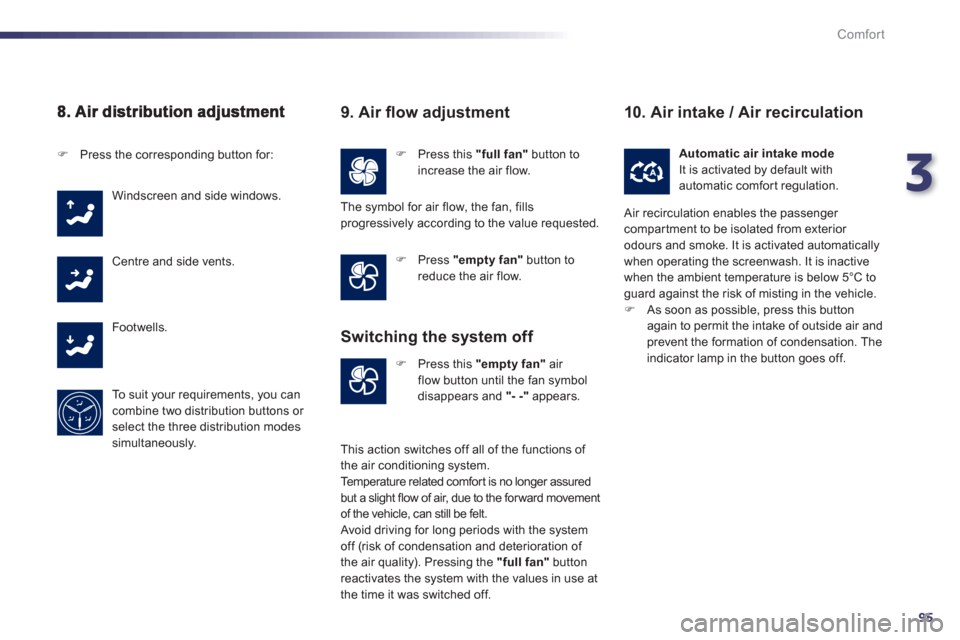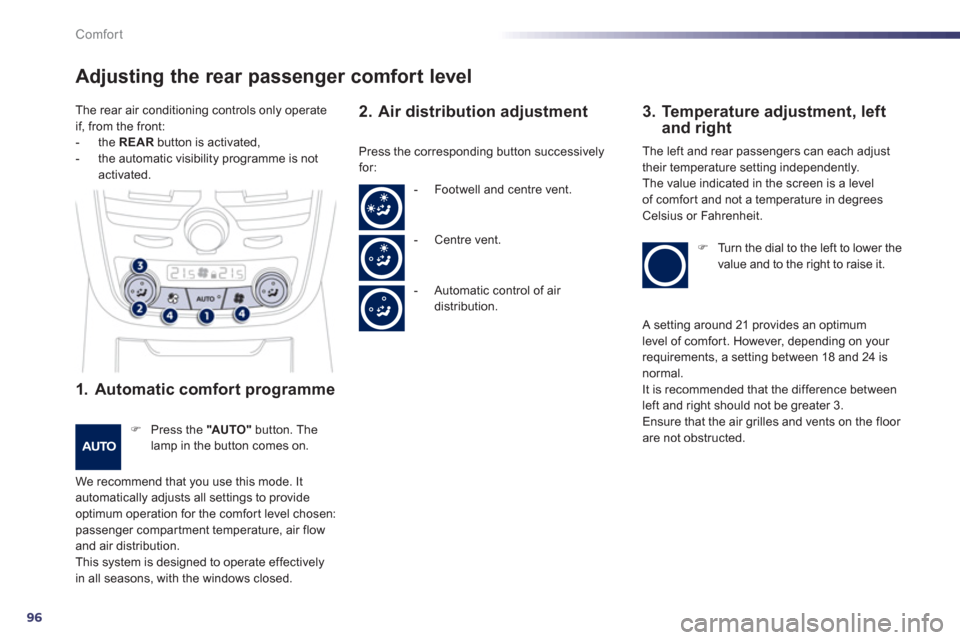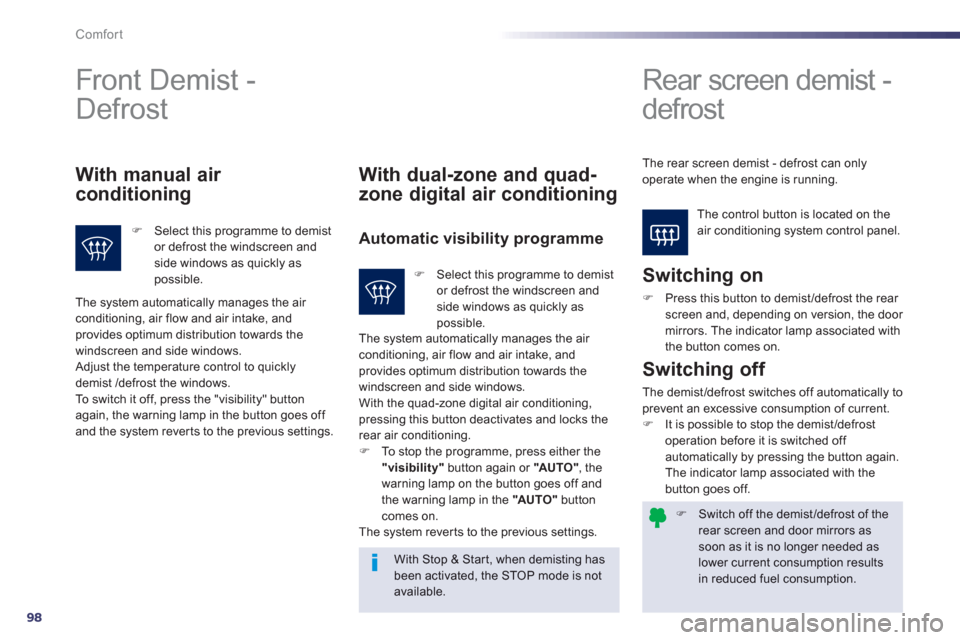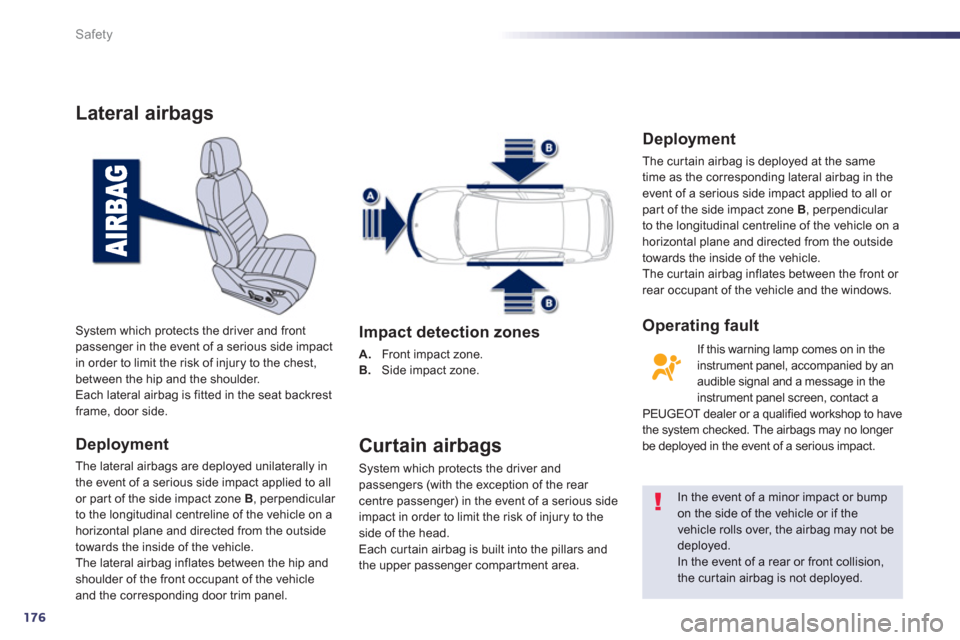2013 Peugeot 508 Hybrid window
[x] Cancel search: windowPage 94 of 340

92
Comfort
8. Air distribution adjustment
FPress the corresponding button for:
Windscreen and side windows.
Centre and side vents.
F
ootwells.
To s u i t
your requirements, you cancombine two distribution buttons or select the three distribution modes
simultaneously.
9. Air fl ow adjustment
FPress this "full fan"button toincrease the air flow.
FPress "empty fan"
button to reduce the air flow.
10. Air intake / Air recirculation
FPress this "empty fan"
air flow button until the fan symbol
disappears and "--"
appears.
Switching the system off
F
Press this button for recirculation of the interior air. The indicator
lamp on the button comes on.
Air recirculation enables the passenger compartment to be isolated from exterior
odours and smoke. It is activated automaticallywhen operating the screenwash.
Avoid driving for long periods with the system off (risk of condensation and deterioration of the air quality).
Pressing the "full fan"buttonreactivates the system with the valuesin use at the time it was switched off.
The air flow symbol, the fan, fills progressivelyaccording to the value requested.
Thi
s action switches off all of the functions of
t
he air conditioning system.
Temperature related comfor t is no longer guaranteed but a slight flow of air, due to theforward movement of the vehicle, can still be felt.
F
As soon as possible, press this buttonagain to permit the intake of outside air and prevent the formation of condensation. The
indicator lamp in the button goes off.
Page 96 of 340

94
Comfort
5. Automatic visibilityprogramme
6. Mono-zone / Quad-zone
7. Air conditionin
g On / Off
Manual o
peration
If you wish, you can change one of settings provided by the system. The other functions will still be controlled automatically.
Press one of the Soft/Auto/Fast buttons toreturn to fully automatic operation.
On entering the vehicle, if the interior temperature is much colder or warmer than the comfort value, there is noneed to change the value displayed in order to obtain the comfor t required.The system corrects the differencein temperature automatically and as quickly as possible.
See "Front demisting-defrosting". Press this button to apply the driver's
comfort setting value to the front and
rear passengers (mono-zone). The
indicator lamp on the button comes on.
The air conditioning is designed to
operate effectively in all seasons,
with the windows closed.
It allows you:
-
in summer, to lower the temperature,
- in winter, above 3°C, to improve demisting
performance.
Switchin
g onF Press the "A/C"button, the associated green indicator lamp comes on. The air conditioning does not operate when
the air flow control is set to off.
Switching offF Press the "A/C"button again, the
associated green indicator lamp goes off.
Switching off the air conditioning may result in
some discomfort (humidity, misting).
For maximum cooling or heating of thepassenger compar tment, it is possibleto exceed the minimum value 14 or themaximum value 28. F
Turn the dial 3
or 4
to the left until"LO"is displayed or to the right until "HI"
is displayed.
With Stop & Star t, when demisting hasbeen activated, the STOP mode is notavailable.
Page 97 of 340

3
95
Comfort
F Press this "full fan"button toincrease the air flow.F
Press the corresponding button for:
Windscreen and side windows.
Centre and side vents.
Footwells.
To s u i t
your requirements, you cancombine two distribution buttons or select the three distribution modes
simultaneously.
F
Press "empty fan"button to reduce the air flow.
F
Press this "empty fan"
air
flow button until the fan symbol
disappears and "- -"
appears.
Automatic air intake mode
It is activated by default with automatic comfort regulation.
9. Air fl ow adjustment
The symbol for air flow, the fan, fills progressively according to the value requested.
Switching the system off
This action switches off all of the functions of
the air conditioning system.
Temperature related comfor t is no longer assured
but a slight flow of air, due to the for ward movement
of the vehicle, can still be felt.
Avoid drivin
g for long periods with the system
o
ff (risk of condensation and deterioration of
the air quality). Pressing the "full fan"
buttonreactivates the system with the values in use at
the time it was switched off.
10. Air intake / Air recirculation
Air recirculation enables the passenger compar tment to be isolated from exterior odours and smoke. It is activated automatically
when operating the screenwash. It is inactive
when the ambient temperature is below 5°C to
guard against the risk of misting in the vehicle. F As soon as possible, press this button
again to permit the intake of outside air and prevent the formation of condensation. The
indicator lamp in the button goes off.
Page 98 of 340

96
Comfort
Adjusting the rear passenger comfort level
1. Automatic comfort programme
F Press the "AUTO"button. The lamp in the button comes on.
We recommend that you use this mode. It automatically adjusts all settings to provide
optimum operation for the comfor t level chosen: passenger compar tment temperature, air flowand air distribution.
This system is designed to operate effectivelyin all seasons, with the windows closed.
2. Air distribution adjustment
3. Temperature adjustment, leftand right
Press the corresponding button successively
f
or: The le
ft and rear passengers can each adjust
their temperature setting independently.
The value indicated in the screen is a level
of comfor t and not a temperature in degreesCelsius or Fahrenheit.
FTurn the dial to the left to lower the
value and to the right to raise it.
- F
ootwell and centre vent.
-
Centre vent.
- A
utomatic control of air distribution.
The rear air conditionin
g controls only operate
if, from the front:
- th
e REARbutton is activated,
- the automatic visibilit
y programme is notactivated.
A setting around 21 provides an optimum
level of comfor t. However, depending on your
requirements, a setting between 18 and 24 isnormal.
It is recommended that the difference between
left and right should not be greater 3.
Ensure that the air grilles and vents on the floor are not obstructed.
Page 100 of 340

98
Comfort
F Switch off the demist/defrost of the rear screen and door mirrors assoon as it is no longer needed as lower current consumption results in reduced fuel consumption.
Front Demist -
Defrost
Rear screen demist -
defrost
The control button is located on theair conditioning system control panel.
With manual air
conditioning
F Select this programme to demistor defrost the windscreen and side windows as quickly aspossible.
With dual-zone and quad-
zone di
gital air conditioning
Automatic visibility programme
Switching on
F
Press this button to demist/defrost the rear screen and, depending on version, the door mirrors. The indicator lamp associated with
the button comes on.
With Stop & Star t, when demisting has been activated, the STOP mode is not available.
Switching off
The demist/defrost switches off automatically toprevent an excessive consumption of current. F
It is possible to stop the demist/defrost
operation before it is switched off automatically by pressing the button again.
The indicator lamp associated with the
button
goes off.
The system automatically manages the air conditioning, air flow and air intake, and provides optimum distribution towards the
windscreen and side windows.
Adjust the temperature control to quickly
demist /defrost the windows.
To switch it off, press the "visibility" button again, the warning lamp in the button goes off
and the system rever ts to the previous settings.
F Select this programme to demist or defrost the windscreen andside windows as quickly as possible.
The system automatically manages the air conditioning, air flow and air intake, and
provides optimum distribution towards the
w
indscreen and side windows.
With the quad-zone digital air conditioning,
pressing this button deactivates and locks the
rear air conditioning. F To stop the programme, press either the "visibility"button again or "AU TO "
, the
warning lamp on the button goes off and
the warning lamp in the "AU TO "buttoncomes on.
The system rever ts to the previous settings.
The rear screen demist - de
frost can onlyoperate when the engine is running.
Page 161 of 340

6
159
Child safety
The incorrect installation of a child seat in avehicle compromises the child's protection in the event of an accident.
Remember to fasten the seat belts or the child seat harnesses keeping the slack relative to the child's body to a minimum,
even for shor t journeys.
When installing a child seat using the seat belt, ensure that the seat belt is tightenedcorrectly on the child seat and that it secures the child seat firmly on the seat of your vehicle. If your passenger seat is adjustable, move it for wards if necessary.
For optimum installation of the "forwards-facing" child seat, ensure that the back of the child seat is in contact with the back of the vehicle's seat and that the head restraint does not cause any discomfort.
If the head restraint has to be removed, ensure that it is stored or attached securely to prevent it from being thrown around the vehicle in the event of sharp braking.
Advice on child seats
As a safety precaution, do not leave: - a child or children alone and unsupervised in a vehicle, - a child or an animal in a vehicle whichis exposed to the sun, with the windows closed,
- the keys within reach of children inside the vehicle. To prevent accidental opening of the doors and rear windows, use the "Child lock". Take care not to open the rear windows bymore than one third.To protect young children from the rays of the sun, fit side blinds on the rear windows.
Children under the age of 10 must not travel in the "forwards-facing" position on the front passenger seat, unless the rear seats are already occupied by other children, cannot be used or are absent.
Deactivate the passenger airbag when a
"rearwards-facing" child seat is installed on the front seat. Other wise, the child would risk beingseriously injured or killed if the airbag were to inflate.
Installing a booster seat
The chest par t of the seat belt must be positioned on the child's shoulder without touching the neck.
Ensure that the lap part of the seat belt passes correctly over the child's thighs.
PEUGEOT recommends the use of a booster seat which has a back, fitted with a seat belt guide at shoulder level.
Page 166 of 340

164
Child safety
Electric child lock
Switching on
FWith the ignition on, press this button.The indicator lamp in the button comes on, accompanied by a message to confirm that the child lock is on.
This indicator lamp remains on until the child
l
ock is switched off.
It is still possible to open the doors from the
outside and operate the rear electric windows
from the driver's control panel.
Switching off
F
With the ignition on, press this button
again.
The indicator lamp in the button goes off,
accompanied by a message to confirm that thechild lock is off.
This indicator lamp remains off while the child
lock is switched off.
Any other status of the indicator lampindicates a fault with the electric child lock.
Have it checked by a PEUGEOT dealer or a qualified workshop.
This system is independent and in nocircumstances does it take the place of
the central locking control. Check the status of the child lock eachtime you switch on the ignition.
Always remove the key from the ignition when leaving the vehicle, even for a short time.
In the event of a serious impact, the electric child lock is switched off automatically to permit the exit of therear passengers.
Page 178 of 340

176
Safety
Lateral airbags
Deployment
The lateral airbags are deployed unilaterally in
the event of a serious side impact applied to all
or par t of the side impact zone B, perpendicular
to the longitudinal centreline of the vehicle on a horizontal plane and directed from the outside
towards the inside of the vehicle.
The lateral airbag inflates between the hip andshoulder of the front occupant of the vehicle and the corresponding door trim panel.
System which protects the driver and frontpassenger in the event of a serious side impact
in order to limit the risk of injury to the chest,
between the hip and the shoulder.
Each lateral airba
g is fitted in the seat backrest frame, door side.
Impact detection zones
A.
Front impact zone.
B. Side impact zone.
Curtain airbags
System which protects the driver and
passengers (with the exception of the rear centre passenger) in the event of a serious side
impact in order to limit the risk of injury to the side of the head.
Each curtain airbag is built into the pillars and
the upper passenger compar tment area.
In the event of a minor impact or bump on the side of the vehicle or if the vehicle rolls over, the airbag may not be
deployed.
In the event of a rear or front collision, the cur tain airbag is not deployed.
Deployment
The cur tain airbag is deployed at the same
time as the corresponding lateral airbag in the event of a serious side impact applied to all or par t of the side impact zone B, perpendicular
to the longitudinal centreline of the vehicle on a horizontal plane and directed from the outside
towards the inside of the vehicle.
The cur tain airbag inflates between the front or
rear occupant of the vehicle and the windows.
If this warnin
g lamp comes on in theinstrument panel, accompanied by an
audible signal and a message in the instrument panel screen, contact a
PEUGEOT dealer or a qualified workshop to have
the system checked. The airbags may no longer
be deployed in the event of a serious impact.
Operating fault